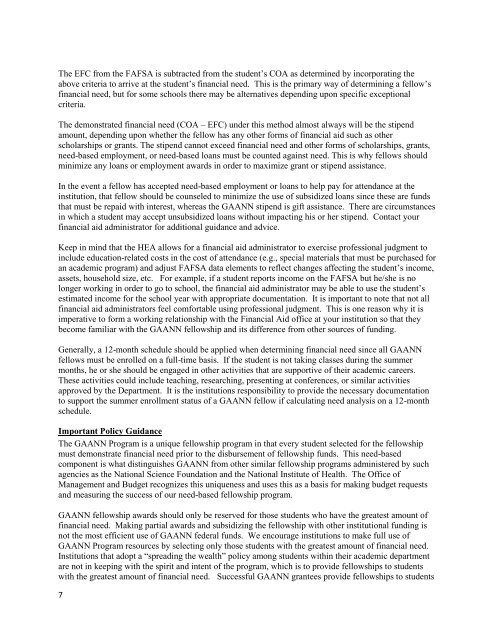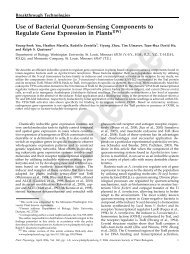GAANN Handbook - Department of Biology
GAANN Handbook - Department of Biology
GAANN Handbook - Department of Biology
Create successful ePaper yourself
Turn your PDF publications into a flip-book with our unique Google optimized e-Paper software.
The EFC from the FAFSA is subtracted from the student’s COA as determined by incorporating theabove criteria to arrive at the student’s financial need. This is the primary way <strong>of</strong> determining a fellow’sfinancial need, but for some schools there may be alternatives depending upon specific exceptionalcriteria.The demonstrated financial need (COA – EFC) under this method almost always will be the stipendamount, depending upon whether the fellow has any other forms <strong>of</strong> financial aid such as otherscholarships or grants. The stipend cannot exceed financial need and other forms <strong>of</strong> scholarships, grants,need-based employment, or need-based loans must be counted against need. This is why fellows shouldminimize any loans or employment awards in order to maximize grant or stipend assistance.In the event a fellow has accepted need-based employment or loans to help pay for attendance at theinstitution, that fellow should be counseled to minimize the use <strong>of</strong> subsidized loans since these are fundsthat must be repaid with interest, whereas the <strong>GAANN</strong> stipend is gift assistance. There are circumstancesin which a student may accept unsubsidized loans without impacting his or her stipend. Contact yourfinancial aid administrator for additional guidance and advice.Keep in mind that the HEA allows for a financial aid administrator to exercise pr<strong>of</strong>essional judgment toinclude education-related costs in the cost <strong>of</strong> attendance (e.g., special materials that must be purchased foran academic program) and adjust FAFSA data elements to reflect changes affecting the student’s income,assets, household size, etc. For example, if a student reports income on the FAFSA but he/she is nolonger working in order to go to school, the financial aid administrator may be able to use the student’sestimated income for the school year with appropriate documentation. It is important to note that not allfinancial aid administrators feel comfortable using pr<strong>of</strong>essional judgment. This is one reason why it isimperative to form a working relationship with the Financial Aid <strong>of</strong>fice at your institution so that theybecome familiar with the <strong>GAANN</strong> fellowship and its difference from other sources <strong>of</strong> funding.Generally, a 12-month schedule should be applied when determining financial need since all <strong>GAANN</strong>fellows must be enrolled on a full-time basis. If the student is not taking classes during the summermonths, he or she should be engaged in other activities that are supportive <strong>of</strong> their academic careers.These activities could include teaching, researching, presenting at conferences, or similar activitiesapproved by the <strong>Department</strong>. It is the institutions responsibility to provide the necessary documentationto support the summer enrollment status <strong>of</strong> a <strong>GAANN</strong> fellow if calculating need analysis on a 12-monthschedule.Important Policy GuidanceThe <strong>GAANN</strong> Program is a unique fellowship program in that every student selected for the fellowshipmust demonstrate financial need prior to the disbursement <strong>of</strong> fellowship funds. This need-basedcomponent is what distinguishes <strong>GAANN</strong> from other similar fellowship programs administered by suchagencies as the National Science Foundation and the National Institute <strong>of</strong> Health. The Office <strong>of</strong>Management and Budget recognizes this uniqueness and uses this as a basis for making budget requestsand measuring the success <strong>of</strong> our need-based fellowship program.<strong>GAANN</strong> fellowship awards should only be reserved for those students who have the greatest amount <strong>of</strong>financial need. Making partial awards and subsidizing the fellowship with other institutional funding isnot the most efficient use <strong>of</strong> <strong>GAANN</strong> federal funds. We encourage institutions to make full use <strong>of</strong><strong>GAANN</strong> Program resources by selecting only those students with the greatest amount <strong>of</strong> financial need.Institutions that adopt a “spreading the wealth” policy among students within their academic departmentare not in keeping with the spirit and intent <strong>of</strong> the program, which is to provide fellowships to studentswith the greatest amount <strong>of</strong> financial need. Successful <strong>GAANN</strong> grantees provide fellowships to students7



